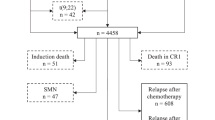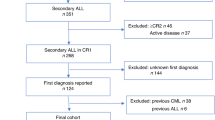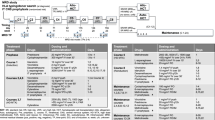Abstract
Data on secondary acute lymphoblastic leukaemia (sALL) following ALL treatment are very rare. However, the incidence might be underestimated as sALLs without a significant lineage shift might automatically be diagnosed as relapses. Examination of immunoglobulin and T-cell receptor gene rearrangements brought a new tool that can help in discrimination between relapse and sALL. We focused on the recurrences of childhood ALL to discover the real frequency of the sALL after ALL treatment. We compared clonal markers in matched presentation and recurrence samples of 366 patients treated according to the Berlin–Frankfurt–Munster (BFM)-based protocols. We found two cases of sALL and another three, where the recurrence is suspicious of being sALL rather than relapse. Our proposal for the ‘secondary ALL after ALL’ diagnostic criteria is as follows: (A) No clonal relationship between diagnosis and recurrence; (B) significant immunophenotypic shift – significant cytogenetic shift – gain/loss of a fusion gene. For the sALL (A) plus at least one (B) criterion should be fulfilled. With these criteria, the estimated frequency of the sALL after ALL is according to our data 0.5–1.5% of ALL recurrences on BFM-based protocols. Finally, we propose a treatment strategy for the patients with secondary disease.
This is a preview of subscription content, access via your institution
Access options
Subscribe to this journal
Receive 12 print issues and online access
$259.00 per year
only $21.58 per issue
Buy this article
- Purchase on Springer Link
- Instant access to full article PDF
Prices may be subject to local taxes which are calculated during checkout
Similar content being viewed by others
References
Hunger SP, Sklar J, Link MP . Acute lymphoblastic leukemia occurring as a second malignant neoplasm in childhood: report of three cases and review of the literature. J Clin Oncol 1992; 10: 156–163.
Geetha N, SreedeviAmma N, Kusumakumary P, Lali VS, Nair MK . Acute lymphoblastic leukemia occurring as a second malignancy: report of a case and review of literature. Pediatr Hematol Oncol 1999; 16: 267–270.
Neglia JP, Meadows AT, Robison LL, Kim TH, Newton WA, Ruymann FB et al. Second neoplasms after acute lymphoblastic leukemia in childhood. N Engl J Med 1991; 325: 1330–1336.
Kimball Dalton VM, Gelber RD, Li F, Donnelly MJ, Tarbell NJ, Sallan SE . Second malignancies in patients treated for childhood acute lymphoblastic leukemia. J Clin Oncol 1998; 16: 2848–2853.
Loning L, Zimmermann M, Reiter A, Kaatsch P, Henze G, Riehm H et al. Secondary neoplasms subsequent to Berlin–Frankfurt–Munster therapy of acute lymphoblastic leukemia in childhood: significantly lower risk without cranial radiotherapy. Blood 2000; 95: 2770–2775.
Bhatia S, Sather HN, Pabustan OB, Trigg ME, Gaynon PS, Robison LL . Low incidence of second neoplasms among children diagnosed with acute lymphoblastic leukemia after 1983. Blood 2002; 99: 4257–4264.
Bhatia S, Sklar C . Second cancers in survivors of childhood cancer. Nat Rev Cancer 2002; 2: 124–132.
Szczepanski T, Willemse MJ, Kamps WA, van Wering ER, Langerak AW, van Dongen JJ . Molecular discrimination between relapsed and secondary acute lymphoblastic leukemia: proposal for an easy strategy. Med Pediatr Oncol 2001; 36: 352–358.
Szczepanski T, Willemse MJ, Brinkhof B, van Wering ER, van der Burg M, van Dongen JJ . Comparative analysis of Ig and TCR gene rearrangements at diagnosis and at relapse of childhood precursor-B-ALL provides improved strategies for selection of stable PCR targets for monitoring of minimal residual disease. Blood 2002; 99: 2315–2323.
Pongers-Willemse MJ, Seriu T, Stolz F, d'Aniello E, Gameiro P, Pisa P et al. Primers and protocols for standardized detection of minimal residual disease in acute lymphoblastic leukemia using immunoglobulin and T cell receptor gene rearrangements and TAL1 deletions as PCR targets: report of the BIOMED-1 CONCERTED ACTION: investigation of minimal residual disease in acute leukemia. Leukemia 1999; 13: 110–118.
Szczepanski T, Willemse MJ, van Wering ER, van Weerden JF, Kamps WA, van Dongen JJ . Precursor-B-ALL with D(H)-J(H) gene rearrangements have an immature immunogenotype with a high frequency of oligoclonality and hyperdiploidy of chromosome 14. Leukemia 2001; 15: 1415–1423.
van der Velden VH, Hochhaus A, Cazzaniga G, Szczepanski T, Gabert J, van Dongen JJ . Detection of minimal residual disease in hematologic malignancies by real-time quantitative PCR: principles, approaches, and laboratory aspects. Leukemia 2003; 17: 1013–1034.
van Dongen JJ, Langerak AW, Bruggemann M, Evans PA, Hummel M, Lavender FL et al. Design and standardization of PCR primers and protocols for detection of clonal immunoglobulin and T-cell receptor gene recombinations in suspect lymphoproliferations: report of the BIOMED-2 Concerted Action BMH4-CT98-3936. Leukemia 2003; 17: 2257–2317.
Langerak AW, Szczepanski T, van der Burg M, Wolvers-Tettero IL, van Dongen JJ . Heteroduplex PCR analysis of rearranged T cell receptor genes for clonality assessment in suspect T cell proliferations. Leukemia 1997; 11: 2192–2199.
Meyer C, Schneider B, Reichel M, Angermueller S, Strehl S, Schnittger S et al. Diagnostic tool for the identification of MLL rearrangements including unknown partner genes. Proc Natl Acad Sci USA 2005; 102: 449–454.
Bene MC, Castoldi G, Knapp W, Ludwig WD, Matutes E, Orfao A et al. Proposals for the immunological classification of acute leukemias. European Group for the Immunological Characterization of Leukemias (EGIL). Leukemia 1995; 9: 1783–1786.
Massenkeil G, Nagy M, Lawang M, Rosen O, Genvresse I, Geserick G et al. Reduced intensity conditioning and prophylactic DLI can cure patients with high-risk acute leukaemias if complete donor chimerism can be achieved. Bone Marrow Transplant 2003; 31: 339–345.
Brizard A, Huret JL, Benz-Lemoine E, Guilhot F, Giraud C, Tanzer J . Two cases of t(4;11) acute lymphoblastic leukemia (ALL) following ALL without the t(4;11): second or secondary leukemias? Br J Haematol 1991; 79: 130–131.
Millot F, Brizard F, Sorel N, Preudhomme C, Cividin M, Guilhot F et al. Therapy-related acute lymphoblastic leukemia with MLL rearrangement following treatment of Burkitt's leukemia. Leuk Lymphoma 2005; 46: 925–927.
Szczepanski T, van der Velden VH, Raff T, Jacobs DC, van Wering ER, Bruggemann M et al. Comparative analysis of T-cell receptor gene rearrangements at diagnosis and relapse of T-cell acute lymphoblastic leukemia (T-ALL) shows high stability of clonal markers for monitoring of minimal residual disease and reveals the occurrence of second T-ALL. Leukemia 2003; 17: 2149–2156.
Hunger SP, Tkachuk DC, Amylon MD, Link MP, Carroll AJ, Welborn JL et al. HRX involvement in de novo and secondary leukemias with diverse chromosome 11q23 abnormalities. Blood 1993; 81: 3197–3203.
Lo Nigro L, Cazzaniga G, Di Cataldo A, Pannunzio A, D'Aniello E, Masera G et al. Clonal stability in children with acute lymphoblastic leukemia (ALL) who relapsed five or more years after diagnosis. Leukemia 1999; 13: 190–195.
Vora A, Frost L, Goodeve A, Wilson G, Ireland RM, Lilleyman J et al. Late relapsing childhood lymphoblastic leukemia. Blood 1998; 92: 2334–2337.
Kim M, Lim J, Kim Y, Han K, Kang CS, Kim HJ et al. A case of therapy-related acute myeloid leukemia associated with inv(16), with subsequent development of t(9;22). Leukemia 2006; 20: 746–748.
Tsuchiya H, Migita M, Yamamori S, Kaneko Y, Adachi N, Nakamura T et al. A late-appearing Philadelphia chromosome in acute lymphoblastic leukemia confirmed by expression of BCR-ABL mRNA. Leukemia 1995; 9: 1689–1693.
Tchirkov A, Bons JM, Chassagne J, Schoepfer C, Kanold J, Briancon G et al. Molecular detection of a late-appearing BCR-ABL gene in a child with T-cell acute lymphoblastic leukemia. Ann Hematol 1998; 77: 55–59.
Miller BA, Reid MM, Nell M, Lipton JM, Sallan SE, Nathan DG et al. T-cell acute lymphoblastic leukaemia with late developing Philadelphia chromosome. Br J Haematol 1984; 56: 139–146.
Coad JE, Arthur DC, Gajl-Peczalska KJ, Litz CE . Late-developing Philadelphia chromosomes in a case of T-cell acute lymphoblastic leukemia. Leukemia 1994; 8: 889–894.
Pui CH, Boyett JM, Rivera GK, Hancock ML, Sandlund JT, Ribeiro RC et al. Long-term results of total therapy studies 11, 12 and 13A for childhood acute lymphoblastic leukemia at St Jude Children's Research Hospital. Leukemia 2000; 14: 2286–2294.
Liberzon E, Avigad S, Stark B, Zilberstein J, Freedman L, Gorfine M et al. Germ-line ATM gene alterations are associated with susceptibility to sporadic T-cell acute lymphoblastic leukemia in children. Genes Chromosomes Cancer 2004; 39: 161–166.
Zuna J, Ford AM, Peham M, Patel N, Saha V, Eckert C et al. TEL deletion analysis supports a novel view of relapse in childhood acute lymphoblastic leukemia. Clin Cancer Res 2004; 10: 5355–5360.
Ford AM, Fasching K, Panzer-Grumayer ER, Koenig M, Haas OA, Greaves MF . Origins of ‘late’ relapse in childhood acute lymphoblastic leukemia with TEL-AML1 fusion genes. Blood 2001; 98: 558–564.
Acknowledgements
We acknowledge Professor Willem A Kamps the chairman of DCLSG ALL-8 study. The work was supported by grant 21620813 (MSMT CR) and by the Programme Hospitalier de Recherche Clinique (PHRC-AOM02 003).
Author information
Authors and Affiliations
Corresponding author
Rights and permissions
About this article
Cite this article
Zuna, J., Cavé, H., Eckert, C. et al. Childhood secondary ALL after ALL treatment. Leukemia 21, 1431–1435 (2007). https://doi.org/10.1038/sj.leu.2404718
Received:
Revised:
Accepted:
Published:
Issue Date:
DOI: https://doi.org/10.1038/sj.leu.2404718
Keywords
This article is cited by
-
A case of an unusual lineage switch in late relapse ALL—is it actually a secondary leukemia?
Journal of Hematopathology (2020)
-
A revised definition for cure of childhood acute lymphoblastic leukemia
Leukemia (2014)
-
Very early/early relapses of acute lymphoblastic leukemia show unexpected changes of clonal markers and high heterogeneity in response to initial and relapse treatment
Leukemia (2011)



